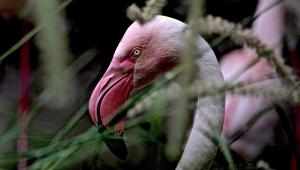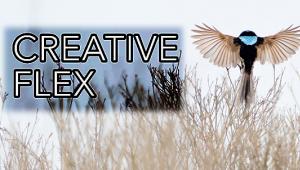Get Your Head On Straight; A Guide To Tripod Heads
You may have set out to buy the ultimate tripod, only to discover that you'll
also have to buy a separate head to shoulder the burden of your cameras. Or
you may want to upgrade to a head better suited to your style of photography.
For example, I wouldn't use the same head in my studio that I use when
traveling: I'd want something lighter, with faster setup when on the go.
While online shopping is convenient, it does have its drawbacks with some things.
To begin, you really have to mount a camera on the head and see how it feels.
You may find an Allen wrench is needed to remove an old head, or securely attach
the new one (note the two or three retaining screws in the top plate of the
tripod and the ridges in the base of the head)--a requirement in heavy-duty
gear that prevents the head from coming loose when moving about or spinning
off when you pan.
OK, now let's say you're heading out to your dealer or even shopping
online. You can help yourself by (1) noting what gear will be used primarily,
(2) the size of the tripod top plate, to match the base of the head--the
disparity should be minimal, if at all, and (3) the size of the tripod top plate/centerpost
mounting screw to match the screw threads on the head (normally 1/4 or 3/8")--there
are adapter bushings and some tripods have reversible screws (check that out
on your tripod).
 |
 |
|
|
||
The Type Of Head Makes A Difference
There are several classes of tripod heads. The first few groups are those we
may be most familiar with, but even here there are numerous variations on a
familiar theme. The rest are quite esoteric, and meet special needs. With any
head, remember to add the camera on top to get a better sense of the overall
height (tripod legs normally extended). Without centerpost extension, the combination
should reach eye level, or close to it, so you don't find yourself standing
on tiptoes or requiring a stepping stool.
1. Three-way pan/tilt head (or simply "pan" head)--the
most common type of head and one we're all familiar with, has knobs or
handles to control up/down tilt, sideways tilt, and panning. These heads can
be very low-profile, with fewer handles, or boxy and towering, seemingly built
like a Sherman tank. The handles and locking mechanisms, along with fluidity
of movement, provide your gateway to ultimate control. The 3D head is a simpler,
lighter pan head featuring knobs or ratchet handles with considerable freedom
of movement--a great choice for travel. The two-way head (commonly sold
for video) lacks sideways tilt for verticals but may provide a rotating camera
mounting plate to suitably re-orient the camera, making it applicable to still
photography. Pan heads often come with one or multiple bubble/spirit levels.
 |
|
|
2. Ball-and-socket head (or simply "ball" head)--there
are no protruding handles, and control may be limited to just one knob. These
essentially come in two flavors: center ball, with the ball and platform centered
over the base, and off-center, where the ball joint is off to one side. Economical,
compact ball heads are generally meant to properly handle light loads, preferably
nothing more than an SLR with zoom lens, if even that. More robust designs can
handle anything up to an 8x10 view camera or more, and in fact are often used
in conjunction with heavy-duty camera/studio stands. The grip-action head is
a variety of ball head whereby all control is centered in a handgrip (in place
of knobs/handles). Squeeze the pistol grip to allow movement, release to lock
in place. Ball heads are great for travel, because they're compact. And,
while larger, a grip-action head is especially suited for wildlife and sports,
because it's fast and largely effortless to use (once you get used to
it), letting you respond quickly to the unfolding action. Ball heads often lack
a bubble level.
The following heads (and accessories) serve special needs and will only be mentioned
briefly (with sources):
3. Clamp heads and window mounts clamp onto a railing, car window, or other stable surface (Manfrotto, Novoflex, Slik, Vanguard). Long-lens supports (Manfrotto, Novoflex) and macro rails (Hakuba, Manfrotto, Novoflex) are respectively designed to facilitate blur-free photography with monster optics and macro lenses. Dual-platform heads (Hakuba, Manfrotto) let you mount two cameras simultaneously. Panoramic and QTVR heads (Arca-Swiss, Kaidan, Manfrotto, Novoflex) are specially made to facilitate creating 360Þ panoramas and QuickTime VR (Virtual Reality) movies. Geared heads (Arca-Swiss, Majestic, Manfrotto) facilitate ultra-precise positioning with heavy loads. Leveling heads (Hakuba, Linhof, Manfrotto) provide omnidirectional 15Þ movement to level the camera no matter what. Gyro stabilizers (Kenyon) dampen vibrations when shooting from a moving vehicle, boat, or aircraft, with a manually supported camera.
 |
|
|
Down To The Nitty-Gritty
Now that we've decided on one or two heads, let's dig deep and make
sure they fit our needs. Obviously, our criteria differ for ball and for pan
heads. But there are several commonalities.
· Load factor. The weight the head will bear may be obvious
from its size, heft, and construction, but to be sure, check the manufacturer's
specifications for "maximum load." The load on the head will not
only affect stability but fluidity of movement as well--we want to avoid
jerky, uneven movement. If the load is too heavy, the head may shift downward
a few degrees (or more) once locked in place.
 |
|
|
· Secure alignment. Surprisingly, when you tighten
the knobs/handles on a head, suddenly the view shifts. Better heads prevent
this from happening. It may require either a bulky or costly head to do the
job right.
· Friction/tension control. A prominent feature on better
ball heads, it affords you vastly improved control with movement. With pan (or
ball) heads, unscrewing the knob or handle in a deliberate fashion may provide
some degree of tension control. Releasing the head with poor friction control
may catapult the camera in a downward arc, so hold on tight.
 |
|
|
· Horizontal panning. It should be smooth, pure
and simple. And preferably controlled separately from the other movements.
· Mounting plate. Which grabs you--or the camera?
More to the point, cork, rubber, or plastic? Some people prefer cork, others
rubber (you may not have a choice in the head you like). Plastic may last longer,
but will it hold the camera as well? I wouldn't necessarily buy a head
based primarily on the surface material.
 |
|
|
- Log in or register to post comments

































